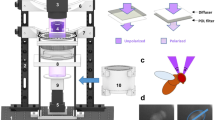Abstract
Insect visual orientation is mostly considered as a stimulus-response phenomenon1,2. This view may be challenged in Drosophila melanogaster by genetic dissection, as we show here. When suspended in a fixed position in a flight simulator3, which transforms torque into angular velocity of the panorama, Drosophila establishes a state of zero net rotation of the panorama (optomotor balance4). The genetic variant rol sol, with greatly reduced optic lobes, is entirely motion-blind but can respond with turning manoeuvres to the position of landmarks. Mutant flies maintain optomotor balance but do so irrespective of the sign of the visual feedback in the simulator, that is, whether angular velocity is inversely or directly proportional to torque. Using the amount, but not the direction, of pattern motion the flies stabilize the panorama by trying out which value of torque has the desired effect. We conclude that operant behaviour is a basic constituent of visual orientation in flies.
This is a preview of subscription content, access via your institution
Access options
Subscribe to this journal
Receive 51 print issues and online access
$199.00 per year
only $3.90 per issue
Buy this article
- Purchase on Springer Link
- Instant access to full article PDF
Prices may be subject to local taxes which are calculated during checkout
Similar content being viewed by others
References
Frankel, G. S. & Gunn, D. L. The Orientation of Animals (Dover, New York, 1961).
Wehner, R. in Handbook of Sensory Physiology Vol. VII/6c, 287–616 (Springer, Heidelberg, 1981).
Reichardt, W. & Wenking, H. Naturwissenschaften 56, 424–425 (1969).
Heisenberg, M. & Wolf, R. Vision in Drosophila (Springer, Heidelberg, 1984).
Götz, K. G. J. comp. PhysioL 99, 468–475 (1975).
Reichardt, W. & Poggio, T. Q. Rev. Biophys. 9, 311–375 (1976).
Fischbach, K. F. & Heisenberg, M. Proc. natn. Acad. Sci. U.S.A. 78, 1105–1109 (1981).
Götz, K. G. Verh. dt. zooL Ges., 83–99 (1983).
Adler, J. Scient. Am. 234, Pt. 4 40–47 (1976).
Metzger, W. Gesetze des Sehens 2nd edn (Kramer, Frankfurt, 1953).
Author information
Authors and Affiliations
Rights and permissions
About this article
Cite this article
Wolf, R., Heisenberg, M. Visual orientation in motion-blind flies is an operant behaviour. Nature 323, 154–156 (1986). https://doi.org/10.1038/323154a0
Received:
Accepted:
Issue Date:
DOI: https://doi.org/10.1038/323154a0
This article is cited by
-
Motion cues from the background influence associative color learning of honey bees in a virtual-reality scenario
Scientific Reports (2021)
-
Object tracking in motion-blind flies
Nature Neuroscience (2013)
-
Evidence for two distinct movement-detecting mechanisms in insect vision
Naturwissenschaften (1993)
-
Reafferent control of optomotor yaw torque inDrosophila melanogaster
Journal of Comparative Physiology A (1988)
-
Flight control during ?free yaw turns? inDrosophila melanogaster
Journal of Comparative Physiology A (1988)
Comments
By submitting a comment you agree to abide by our Terms and Community Guidelines. If you find something abusive or that does not comply with our terms or guidelines please flag it as inappropriate.



